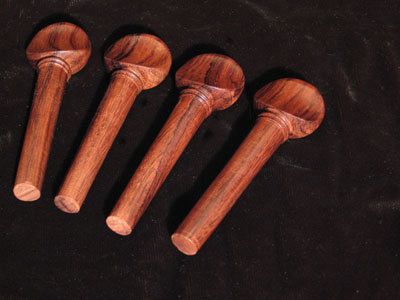Rosewood Wood Pegs
The wooden peg is very close to the heart of a traditional musical instrument.
The peg is a very basic tool. And if you have a lathe, it's pretty easy to make your own pegs. Creating and fitting the wooden peg puts the builder at the very soul of the music--no gears, castings, no manufactured screws or handles are necessary here. Just a little piece of wood and your tools.

 The first step is the rough-saw the peg blanks. We used cocobolo here, a beautiful, hard tropical wood with good characteristics for pegs. The blanks are cut to 3"X1"X7/16". Go for beauty of grain, wood without flaws (pegs work hard!), and no figure.
The first step is the rough-saw the peg blanks. We used cocobolo here, a beautiful, hard tropical wood with good characteristics for pegs. The blanks are cut to 3"X1"X7/16". Go for beauty of grain, wood without flaws (pegs work hard!), and no figure.
 Next the blank is mounted in the 4-jaw chuck of the lathe and centered, then a 3/8" cylinder cut is made on the peg shaft. (Fine hone your lathe tool's cutting edge to get a good finish, needless to say.) The taper for the pegs is that of a standard viola peg, 1/30, or .0333" per inch of length. on the left is shown how to setup the taper on the compound cross-slide for the cut (Remember, you only cut half the taper off each side!).
Next the blank is mounted in the 4-jaw chuck of the lathe and centered, then a 3/8" cylinder cut is made on the peg shaft. (Fine hone your lathe tool's cutting edge to get a good finish, needless to say.) The taper for the pegs is that of a standard viola peg, 1/30, or .0333" per inch of length. on the left is shown how to setup the taper on the compound cross-slide for the cut (Remember, you only cut half the taper off each side!).

 Then the taper is cut and polished to a 400 grit finish. This completes work on the shaft. Now the peg should be a good fit in a test hole bored and reamed by the peg reamer.
Then the taper is cut and polished to a 400 grit finish. This completes work on the shaft. Now the peg should be a good fit in a test hole bored and reamed by the peg reamer.

 The square blank of the handle is marked out in a circle (I just draw around a U.S. quarter coin), and roughly sawn to shape (make it more inventive than the circle--that's just there for a guide). The peg handle is mounted in a tapered sleeve and the neck is turned. This finishes the lathe work.
The square blank of the handle is marked out in a circle (I just draw around a U.S. quarter coin), and roughly sawn to shape (make it more inventive than the circle--that's just there for a guide). The peg handle is mounted in a tapered sleeve and the neck is turned. This finishes the lathe work.

 The peg handle is then profiled to give it a comfortable grip and an attractive shape. This is done with cylindrical sanders, 400 grit nail finishing boards, and 0000 steel wool and knife-trimming the edges for a simple faceted finish. A rubbed Tung Oil varnish on the handle brings out the color of the cocobolo nicely.
The peg handle is then profiled to give it a comfortable grip and an attractive shape. This is done with cylindrical sanders, 400 grit nail finishing boards, and 0000 steel wool and knife-trimming the edges for a simple faceted finish. A rubbed Tung Oil varnish on the handle brings out the color of the cocobolo nicely.
 Installing the wooden peg is a simple process, but requires care. Here is a little article on that.
Installing the wooden peg is a simple process, but requires care. Here is a little article on that.

